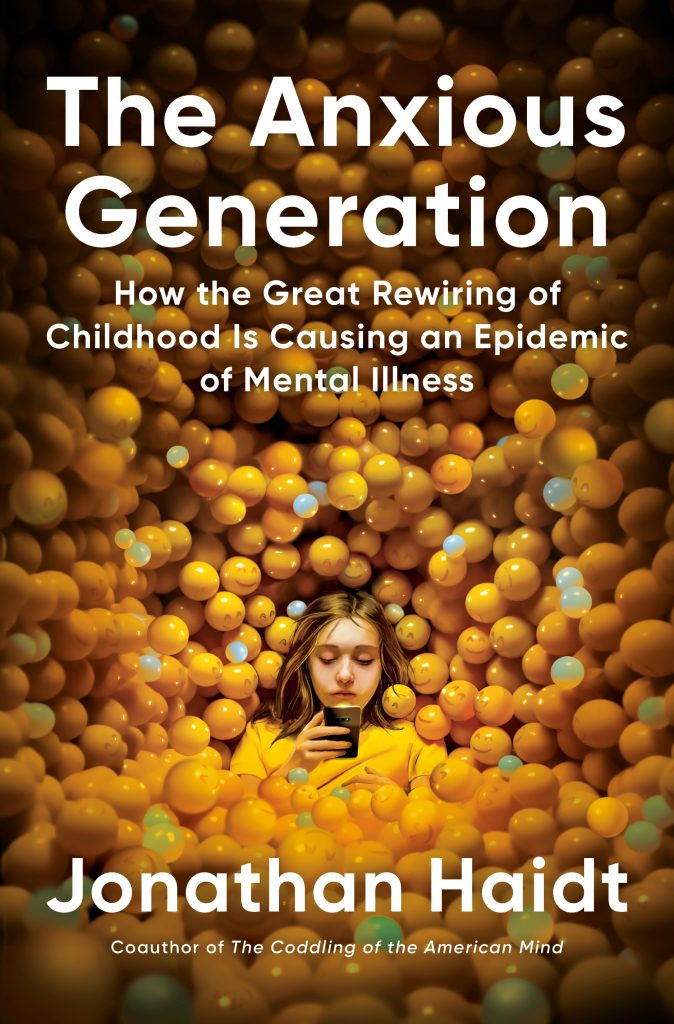
Buy The Book
Chapter
- ✦ Introduction
- ✦ The Surge Of Suffering
- ✦ What Children Need To Do In Childhood
- ✦ Discover Mode And The Need For Risky Play
- ✦ Puberty And The Blocked Transition To Adulthood
- ✦ The Four Foundational Harms: Social Deprivation, Sleep Deprivation, Attention Fragmentation, And Addiction
- ✦ Why Social Media Harms Girls More Than Boys
- ✦ What Is Happening to Boys?
- ✦ Spiritual Elevation and Degradation
- ✦ Preparing for Collective Action
- ✦ What Governments and Tech Companies Can Do Now
- ✦ What Schools Can Do Now
- ✦ What Parents Can Do Now
- ✦ Conclusion: Bring Childhood Back to Earth
The Anxious Generation: How the Great Rewiring of Childhood Caused an Epidemic of Mental Illness

About
In *The Anxious Generation: How the Great Rewiring of Childhood Caused an Epidemic of Mental Illness*, author Jonathan Haidt explores the alarming decline in adolescent mental health since the early 2010s. Haidt, a social psychologist known for his work on morality and culture, argues that the widespread adoption of smartphones and social media, combined with overprotective parenting, has fundamentally altered childhood experiences. He highlights how the shift from play-based to phone-based childhoods has deprived children of essential opportunities for risk-taking and social interaction, leading to increased rates of anxiety, depression, and self-harm.
Through a comprehensive analysis of mental health statistics and societal trends, Haidt identifies key mechanisms driving this crisis, including social comparison and isolation. He advocates for practical reforms to restore a healthier childhood environment, emphasizing the need for balance between digital engagement and real-world play. This book serves as both a wake-up call and a roadmap for parents, educators, and policymakers to address the mental health epidemic affecting today’s youth.

Spark
Learn
Review
✦ Introduction
Growing up in a digital age has profoundly reshaped childhood, leading to unprecedented challenges for today’s youth. The rapid rise of technology, particularly smartphones and social media, has created an environment where children are increasingly isolated from real-world interactions. This shift has not only disrupted traditional play but has also fostered anxiety and mental health issues among adolescents. The consequences of this “great rewiring” are alarming, as many young people struggle with feelings of inadequacy and social pressure in a hyper-connected world. The narrative draws parallels between the risks faced by children on Earth and the hypothetical dangers of sending them to Mars, emphasizing the urgent need to address the detrimental effects of modern technology on childhood development. By understanding these dynamics, society can begin to implement changes that prioritize the well-being of future generations.
✦ The Surge Of Suffering
A significant decline in adolescent mental health has emerged since the early 2010s, marked by a troubling increase in anxiety and depression among young people. Conversations with parents reveal a shared sense of frustration and helplessness as they confront their children’s growing dependence on smartphones and social media. Many express feelings of losing their children to technology, struggling to maintain family connections amidst pervasive digital distractions.
Data indicates a sharp rise in mental health disorders, particularly among teenage girls, with one in four experiencing major depressive episodes by 2020. This crisis reflects broader societal changes linked to the rise of smartphones and social media, which have fundamentally altered childhood experiences. The pervasive presence of digital technology has disrupted essential developmental milestones, leading to increased feelings of isolation and distress.
The narrative highlights that this generation’s experience differs markedly from previous ones, as they navigate adolescence with constant online connectivity. The shift from a play-based to a phone-based childhood has profound implications for mental health, as young people increasingly engage in virtual interactions at the expense of real-world experiences. This transformation has contributed to a collective sense of anxiety and disconnection, underscoring the urgent need for action to address the challenges facing today’s youth. Ultimately, it calls for a reevaluation of how technology is integrated into children’s lives to foster healthier development and well-being.
✦ What Children Need To Do In Childhood
Childhood development has been fundamentally altered by the shift from a play-based to a phone-based environment. This transformation has deprived children of essential experiences critical for their growth. A healthy childhood is characterized by opportunities for free play, which fosters social, cognitive, and emotional skills. Play allows children to learn through trial and error, developing competencies necessary for adulthood.
The decline of unstructured play began in the late 20th century, as societal fears led to increased supervision and restrictions on children’s independence. As smartphones became ubiquitous, children increasingly turned to screens for entertainment, reducing their time spent in physical play. This shift has significant implications; children are missing out on vital interactions that help them learn to navigate social complexities and manage emotions.
Additionally, the nature of social interactions has changed. Online platforms promote asynchronous communication that lacks the depth and immediacy of face-to-face interactions. This disconnection can hinder emotional development, as children miss out on the nuanced feedback provided by real-world relationships. The constant comparison fostered by social media further exacerbates feelings of inadequacy and anxiety, particularly among girls.
Overall, the current generation is experiencing a childhood that limits essential developmental experiences, leading to increased mental health issues. The need for a return to more traditional forms of play and interaction is crucial for fostering healthier emotional and social development in children today.
✦ Discover Mode And The Need For Risky Play
Risky play is essential for healthy childhood development, enabling children to explore limits, build resilience, and acquire critical life skills. Engaging in activities that involve some risk fosters independence and self-regulation, preparing children to navigate challenges effectively. Historically, children had ample opportunities for such play—climbing trees, running freely, and engaging in unsupervised adventures. However, societal fears have led to increased parental overprotection, resulting in a decline in these vital experiences.
The rise of technology and screen time has further diminished opportunities for risky play, as children increasingly turn to screens for entertainment. This shift has profound implications; without engaging in physical play, children miss out on essential interactions that help them develop social skills and emotional intelligence. The nature of social interactions has also changed; online platforms often promote asynchronous communication devoid of the depth found in face-to-face interactions.
The narrative highlights that the absence of risky play can hinder children’s ability to cope with larger challenges later in life, contributing to rising anxiety and mental health issues. Allowing children the freedom to engage in risky play is crucial for fostering resilience and emotional well-being. By embracing this need for risk in play, caregivers can help cultivate competent and confident young adults, ultimately preparing them for the complexities of life. Emphasizing the importance of risky play is vital for reversing the negative trends affecting today’s youth.
✦ Puberty And The Blocked Transition To Adulthood
Puberty and the transition to adulthood have become increasingly obstructed for today’s youth. This blockage stems from a combination of societal changes and the pervasive influence of technology. As adolescents enter puberty, they face unique challenges that are exacerbated by the digital landscape. The traditional markers of growing up—such as increased independence and exploration—are hindered by overprotective parenting and the allure of smartphones, which often distract from real-world experiences.
The onset of puberty typically brings about significant physical, emotional, and social development. However, the current generation finds itself navigating these changes while simultaneously engaging with a virtual world that often prioritizes online interactions over face-to-face connections. This shift has led to a decrease in essential social skills and emotional resilience, as children miss out on critical developmental experiences like risky play and unsupervised exploration.
Moreover, the pressure to maintain an online presence can create feelings of inadequacy and anxiety, particularly among girls who are more susceptible to social comparison. The constant need for validation through likes and shares can overshadow genuine relationships and hinder emotional growth. As a result, many adolescents struggle to form healthy attachments and develop coping mechanisms necessary for adulthood.
Ultimately, the blocked transition to adulthood reflects a broader societal issue where technology has redefined childhood experiences. Addressing these challenges requires a reevaluation of how adolescents engage with both their peers and the digital world, fostering environments that support healthy development during this critical life stage.
✦ The Four Foundational Harms: Social Deprivation, Sleep Deprivation, Attention Fragmentation, And Addiction
The discussion surrounding the four foundational harms—social deprivation, sleep deprivation, attention fragmentation, and addiction—highlights the detrimental effects of a phone-based childhood on young people’s development. Social deprivation arises from the decline in face-to-face interactions, as children increasingly turn to screens for social connection, leading to feelings of isolation and loneliness. This shift has resulted in a significant reduction in the quality and quantity of real-world relationships, which are crucial for emotional and social growth.
Sleep deprivation is another critical issue, exacerbated by excessive screen time. The blue light emitted by devices disrupts natural sleep patterns, causing difficulties in falling asleep and maintaining restful sleep. This lack of adequate rest further impacts mental health, contributing to anxiety and depression.
Attention fragmentation occurs as children are bombarded with notifications and distractions from multiple apps and platforms. This constant interruption makes it challenging for them to focus on tasks, leading to decreased academic performance and increased stress levels. The ability to concentrate is essential for learning and personal development, yet the digital environment promotes superficial engagement over deep focus.
Finally, addiction to technology manifests through compulsive use of smartphones and social media platforms. Many young people find themselves unable to resist the urge to check their devices constantly, often prioritizing online interactions over meaningful real-life experiences. This addiction not only affects mental health but also hinders the development of essential life skills necessary for adulthood.
Together, these harms illustrate how the transition to a phone-based childhood has profoundly affected the well-being of today’s youth, necessitating urgent attention and intervention.
✦ Why Social Media Harms Girls More Than Boys
Social media has a particularly harmful effect on adolescent girls, intensifying pressures related to appearance, social validation, and comparison. The environment created by these platforms amplifies unrealistic beauty standards, leading to body dissatisfaction and increased anxiety. Research indicates that girls are more susceptible to internalizing negative feedback and engaging in social comparison, which can provoke feelings of inadequacy.
The constant exposure to curated images fosters a toxic atmosphere where self-worth becomes tied to online approval. This issue is especially pronounced during puberty, a critical period for identity formation. The competitive nature of social media further exacerbates anxiety and depression among girls, as they feel compelled to maintain an online presence and engage with peers constantly.
Moreover, the need for validation through likes and comments can lead to addictive behaviors, making it difficult for girls to disconnect from their devices. This reliance on social media can result in heightened feelings of loneliness, despite being perpetually connected online.
The chapter emphasizes the urgent need for awareness regarding these challenges and advocates for strategies that can help mitigate the negative effects of social media on girls. Promoting healthier online habits, encouraging critical thinking about media consumption, and fostering real-life connections are essential steps toward improving mental health outcomes for this vulnerable demographic. Ultimately, addressing these issues is crucial for supporting girls in navigating the complexities of adolescence in a digital age.
✦ What Is Happening to Boys?
Boys are facing significant challenges in the context of a phone-based childhood, though their experiences differ from those of girls. The rise of technology, particularly video games and online content, has profoundly influenced boys’ lives. While gaming can foster social connections and skill development, excessive engagement often leads to isolation and a disconnection from real-world activities.
Many boys turn to gaming as a means of escape from stressors, which can result in addictive behaviors. The trend of boys spending increasing amounts of time on screens detracts from physical play and face-to-face interactions, essential for developing emotional regulation and social skills. This shift contributes to difficulties in navigating relationships and managing emotions.
Societal expectations around masculinity further complicate boys’ mental health. Many feel pressured to conform to traditional masculine norms that discourage vulnerability and emotional expression. As a result, boys may exhibit higher rates of externalizing behaviors, such as aggression or withdrawal, rather than seeking help for mental health issues.
The chapter emphasizes the need for a reevaluation of how boys interact with technology and highlights the importance of fostering environments that encourage healthy emotional expression and real-life connections. Addressing these challenges is crucial for supporting boys in navigating their unique developmental needs in today’s digital landscape. Ultimately, recognizing the distinct experiences of boys in this context is vital for promoting their mental well-being and overall development.
✦ Spiritual Elevation and Degradation
Spiritual well-being among adolescents has significantly declined due to the rise of a phone-based childhood. This chapter examines how modern technology disrupts opportunities for meaningful connections with oneself and others, leading to spiritual degradation. The shift from engaging in traditional spiritual practices to reliance on digital interactions has created a void in the lives of young people.
Spiritual elevation involves experiences that foster purpose and connection, yet excessive screen time detracts from reflection and mindfulness. As adolescents increasingly immerse themselves in virtual worlds, they miss out on the communal rituals and shared experiences that historically contributed to a sense of belonging and identity. The decline of these practices has left many feeling isolated and disconnected.
The chapter emphasizes that the pervasive presence of technology often replaces authentic relationships with superficial online interactions. This shift not only affects emotional health but also hinders the development of resilience and coping mechanisms essential for navigating life’s challenges. The absence of spiritual practices can lead to feelings of emptiness and confusion, as young people struggle to find meaning in their lives.
To counteract these trends, integrating mindfulness, community engagement, and authentic connections into daily life is vital. Encouraging adolescents to participate in spiritual practices can help restore a sense of purpose and belonging, ultimately enhancing their overall well-being. By prioritizing spiritual elevation, it is possible to combat the isolating effects of technology and support healthier emotional development among youth.
✦ Preparing for Collective Action
Collective action is essential for addressing the mental health crisis affecting today’s youth. This section highlights the importance of collaboration among parents, educators, policymakers, and tech companies to create healthier environments for children. A unified approach is necessary to mitigate the adverse effects of technology on mental health.
Individual efforts are insufficient; systemic change is vital to reverse harmful trends. Parents should advocate for policies that prioritize children’s well-being while educators implement curricula that promote critical thinking about technology use. Tech companies must also take responsibility for their products’ impact on young users by designing features that prioritize user safety over engagement metrics.
Grassroots movements driven by concerned citizens can create urgency around these issues. By fostering a culture of collective action, communities can work together to empower children to thrive both online and offline.
The narrative emphasizes that young people are eager to engage in activism and are increasingly aware of how the tech industry exploits them. As they organize and innovate, they will likely find new solutions beyond those proposed in this book and make them happen.
Ultimately, the call for collective action underscores the need for a coordinated response to the challenges posed by a phone-based childhood. By working together across various sectors, it is possible to create supportive environments that promote resilience and well-being among youth, paving the way for healthier development in an increasingly digital world.
✦ What Governments and Tech Companies Can Do Now
Governments and tech companies have a crucial role in addressing the mental health crisis affecting today’s youth. Implementing regulations to limit children’s access to smartphones and social media is essential. Policies could include age restrictions on social media platforms and guidelines that require parental consent for children under a certain age. This approach aims to protect minors from the negative impacts of constant online engagement.
Tech companies are urged to prioritize user safety by designing platforms that minimize addictive features and promote healthier usage patterns. Features such as time limits and reminders can help users manage their screen time more effectively. Additionally, companies should be transparent about the potential harms associated with their products, sharing data with researchers studying these effects.
Collaboration between governments and tech companies is vital for creating comprehensive solutions that address the complexities surrounding youth technology use. By working together toward shared goals focused on child welfare, it is possible to foster healthier digital environments conducive to positive development.
The chapter emphasizes the need for collective action to implement these changes effectively. Engaging parents, educators, and communities in discussions about technology use can create a supportive environment that prioritizes children’s mental health. Ultimately, taking decisive steps now can help mitigate the adverse effects of technology on youth, ensuring that future generations can thrive both online and offline.
✦ What Schools Can Do Now
Schools play a crucial role in shaping how children interact with technology and supporting their mental health. Implementing comprehensive digital literacy programs is essential for educating students about responsible technology use. These programs should teach students to critically evaluate online content and understand the potential impacts of excessive screen time.
Prioritizing social-emotional learning (SEL) is another vital strategy. SEL programs help students develop emotional regulation, resilience, and interpersonal skills, which are increasingly necessary in a digital age. Providing resources such as counseling services and peer support groups can further assist students in coping with stressors related to technology use.
Creating phone-free zones within schools can significantly enhance the learning environment. By requiring students to store their devices during the school day, schools can minimize distractions and encourage face-to-face interactions among peers. This approach fosters authentic connections and promotes engagement with teachers and classmates.
Additionally, schools should encourage outdoor play and unsupervised interactions, allowing children to develop essential social skills through free play. This type of engagement is crucial for emotional growth and helps prepare students for the complexities of adult life.
Ultimately, proactive measures taken by educational institutions are essential for equipping students with the skills needed to thrive in an increasingly complex digital world. By focusing on these strategies, schools can create supportive environments that promote healthier relationships with technology and enhance overall mental well-being among students.
✦ What Parents Can Do Now
Parents play a crucial role in shaping their children’s relationship with technology and supporting their mental health. Establishing clear boundaries around screen time is essential; encouraging designated phone-free periods during family meals fosters awareness of the impacts of excessive device use on well-being.
Modeling healthy behaviors by limiting personal device usage during family interactions creates opportunities for meaningful conversations without distractions. Encouraging outdoor play and participation in extracurricular activities promotes physical engagement while reducing reliance on screens as primary sources of entertainment.
Active involvement from parents is vital in guiding children toward balanced relationships with technology. This includes engaging in open discussions about the potential risks associated with excessive screen time and social media use. By fostering an environment where children feel comfortable expressing their feelings and concerns, parents can help mitigate anxiety and depression.
Additionally, promoting critical thinking about media consumption is essential. Parents should encourage their children to question the content they encounter online and understand the difference between curated online personas and real-life experiences.
Finally, advocating for community initiatives that support healthier childhood environments, such as phone-free schools and increased opportunities for unstructured play, can create a collective effort to combat the negative effects of technology on youth. By implementing these strategies, parents can significantly contribute to improving their children’s mental health and overall development in an increasingly digital world.
✦ Conclusion: Bring Childhood Back to Earth
The call to reclaim childhood from the overwhelming influence of technology, particularly smartphones and social media, is urgent. The shift to a phone-based childhood has led to significant mental health challenges for today’s youth, marked by rising rates of anxiety, depression, and social isolation. This transformation has fundamentally altered how children interact, learn, and develop emotionally.
To counteract these negative effects, implementing foundational reforms is essential: prohibiting smartphones before high school, delaying social media access until age 16, establishing phone-free environments in schools, and promoting more unsupervised play and independence for children. These measures aim to restore the balance between real-world experiences and virtual interactions, allowing children to engage in meaningful social connections and develop essential life skills.
While technology can offer benefits, it is crucial to protect children from its potential harms. By prioritizing face-to-face interactions and fostering environments that encourage exploration and play, communities can help mitigate the mental health crisis affecting today’s youth. Ultimately, bringing childhood back to earth involves collective action from parents, educators, policymakers, and society at large to ensure that children grow up with the necessary support and experiences for healthy development. Emphasizing real-world connections over digital distractions is vital for nurturing resilient and well-adjusted future generations.
For People
– Parents of teenagers
– Educators and school administrators
– Mental health professionals
– Child development researchers
– Policy makers focused on youth welfare
Learn to
– Understanding the impact of technology on youth mental health
– Recognizing the effects of overprotective parenting
– Learning strategies to foster resilience in children
– Gaining insights into the importance of unstructured play
– Exploring solutions to mitigate anxiety in the younger generation









